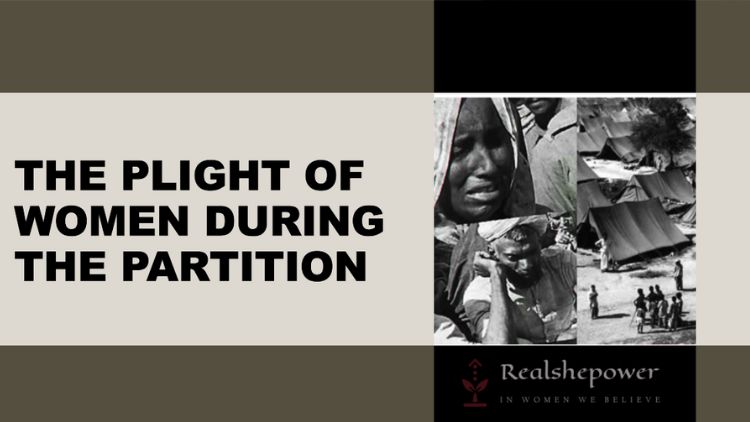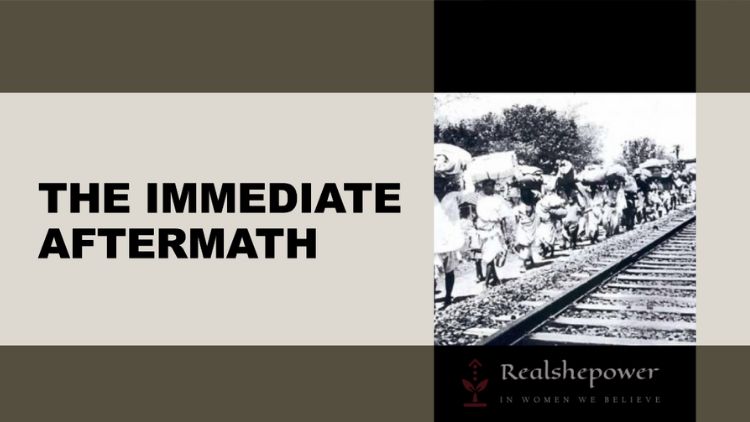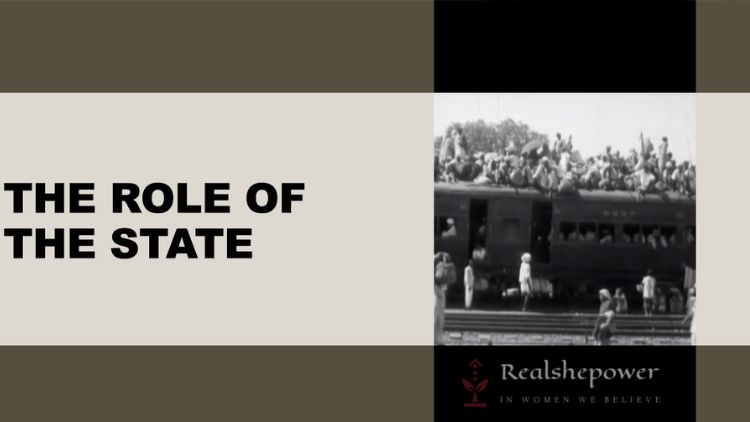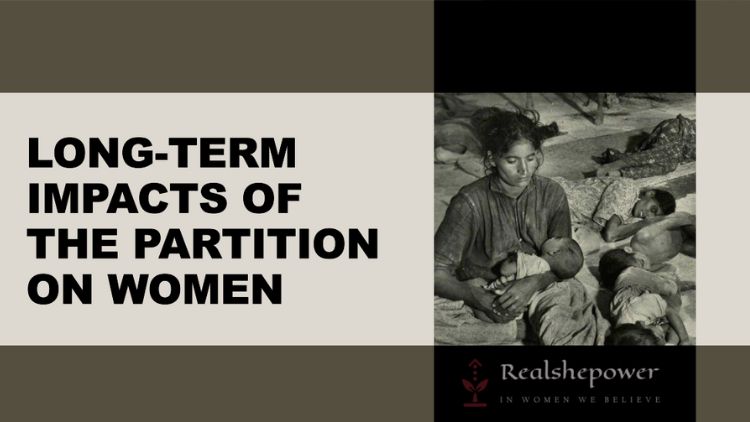The Partition of India and Its Adverse Impact on Women: A Detailed Historical Account


In the annals of history, few events have left a legacy as indelible and harrowing as the 1947 Partition of India. While the geopolitical ramifications of this cataclysmic division have been extensively chronicled, the profound human cost, especially the agonizing plight of women, remains an under-told narrative. Women, often relegated to the margins of historical discourse, found themselves at the epicenter of a storm of violence, displacement, and societal upheaval during the partition. This article seeks to shed light on the profound adversities faced by these women, who became the collateral damage in a high-stakes game of political chess, their lives forever altered by boundaries drawn on a map.
Table of Contents
1. Background of the Partition

The partition of India in 1947 was not an isolated event but the culmination of a series of political, social, and historical developments that spanned decades. To understand the backdrop against which this monumental decision was made, it’s essential to delve into the colonial history of the Indian subcontinent and the rise of nationalist and communal sentiments.
a. The Colonial Context:
The British East India Company began its trade in the Indian subcontinent in the early 17th century. Over the years, it expanded its control, leading to the establishment of the British Raj by the mid-19th century. The British employed a strategic ‘divide and rule’ policy, exacerbating religious, ethnic, and regional differences to maintain control over the vast and diverse Indian population.
b. Rise of Nationalism:
The late 19th and early 20th centuries saw the rise of Indian nationalism. The Indian National Congress (INC), founded in 1885, initially sought greater representation and rights within the British framework. However, as the movement grew, so did the demand for complete independence.
c. Emergence of the Muslim League:
Founded in 1906, the All India Muslim League initially aimed to secure the political rights of Muslims within the broader nationalist movement. However, over time, especially under the leadership of Muhammad Ali Jinnah, it began advocating for a separate nation for Muslims, citing concerns over minority rights in a Hindu-majority India.
d. Communal Tensions:
The 1920s and 1930s witnessed increasing communal tensions. Events like the Khilafat Movement, which sought to restore the Caliphate in Turkey, and the subsequent non-cooperation movement, brought Hindus and Muslims together in a joint struggle against colonial rule. However, the unity was short-lived. Incidents like the Moplah riot in 1921 and subsequent communal riots in various parts of India highlighted the growing rift between the two communities.
e. The Lahore Resolution:
In 1940, the Muslim League passed the Lahore Resolution, which for the first time explicitly demanded “independent states” for Muslims. This is often seen as the formal beginning of the demand for Pakistan.
f. The Endgame:
World War II significantly weakened the British Empire. Post-war, Britain was more willing to relinquish its colonies. The naval mutiny of 1946 and widespread protests made it clear that maintaining control over India was becoming untenable. However, the British were also wary of leaving behind a united India, fearing it would become a significant power. The Mountbatten Plan, unveiled in June 1947, proposed a swift partition, leading to the creation of India and Pakistan in August 1947.
g. The Hastiness:
The decision to partition and its execution were done hastily. Sir Cyril Radcliffe, who had never been to India before, was given the task of drawing the borders within weeks. This hastiness contributed to the chaos, violence, and displacement that followed.
2. The Immediate Aftermath

The announcement of the partition and the subsequent drawing of the Radcliffe Line, which demarcated the borders of the newly formed nations of India and Pakistan, set off a chain of events that had catastrophic implications for the people of the subcontinent.
a. Mass Migration: The partition led to an unprecedented movement of people across the newly drawn borders. It’s estimated that between 10 to 15 million people, fearing for their lives or seeking to be part of a country that aligned with their religious beliefs, uprooted themselves. This migration is considered one of the largest in human history. Families were torn apart, properties were abandoned, and entire communities were displaced.
b. Communal Violence: The migration was accompanied by horrific communal violence. As communities that had coexisted for centuries suddenly found themselves on opposing sides, tensions erupted. Mobs, driven by fear, anger, and revenge, targeted those of the ‘other’ religion. The violence was brutal and indiscriminate, affecting men, women, and children. Conservative estimates suggest that around 200,000 people lost their lives, while some historians believe the number could be as high as 2 million.
c. ‘Ghost Trains’: One of the most haunting symbols of the partition’s violence was the phenomenon of ‘ghost trains.’ Trains packed with refugees, hoping to cross the border to safety, were often attacked. Many of these trains would arrive at their destinations filled with the bodies of those who had been massacred en route. These incidents further fueled animosities and retaliatory violence.
d. Economic and Social Disruption: The partition wasn’t just a division of territory; it was a division of assets, resources, and institutions. The sudden movement of people led to significant economic disruptions. Those who migrated had to abandon their homes, lands, and businesses. They arrived in their new country as refugees, often penniless and dependent on the state or charity. The social fabric of regions, especially in Punjab and Bengal, was altered dramatically, as centuries-old communities were replaced by new ones.
e. Formation of Refugee Camps: With the influx of refugees on both sides of the border, there was an immediate need for shelter and sustenance. Makeshift refugee camps sprang up in various locations, including Delhi, Lahore, and Calcutta. These camps, often overcrowded and with limited resources, became sites of further tragedy. Disease, hunger, and crime were rampant. The governments of both India and Pakistan were ill-prepared to handle the scale of the crisis.
f. Psychological Impact: The trauma of the partition wasn’t limited to physical suffering. The psychological scars ran deep. Families were torn apart, with members sometimes ending up on opposite sides of the border. The violence witnessed and endured led to deep-seated mistrust and animosity, the effects of which can still be felt in the subcontinent’s geopolitics today.
The immediate aftermath of the partition was a period of unparalleled chaos and suffering. The decisions made in the corridors of power had profound and often tragic consequences for the millions who found their lives upended overnight. The legacy of this period continues to shape the narratives and relationships in South Asia.
3. The Plight of Women During the Partition

While both men and women suffered, the nature and extent of the suffering endured by women were distinct and particularly harrowing. Their experiences during this tumultuous period were shaped by their gender, making them vulnerable to specific forms of violence and exploitation.
a. Abductions and Forced Marriages:
- Scale of Abductions: Urvashi Butalia, in her work “The Other Side of Silence,” mentions that nearly 100,000 women were abducted during the partition. These abductions were not random acts of violence but were often organized and systematic.
- Forced Conversions and Marriages: Once abducted, many of these women were forced to convert to the religion of their abductors. They were then married off, often against their will. This was a deliberate act to ensure that these women could never return to their original communities.
- Tattooing and Branding: In some instances, abductors tattooed religious symbols on the women’s bodies. This branding served as a permanent marker of their changed identity and a means to further alienate them from their original communities.
b. Sexual Violence:
- Rape as a Weapon: The partition saw an alarming rise in sexual violence against women. Historians like Ritu Menon and Kamla Bhasin in “Borders & Boundaries: Women in India’s Partition” note that women’s bodies became sites of communal honor. Raping a woman from the opposing community was a way to dishonor and emasculate that community.
- Public Humiliation: There were numerous accounts of women being paraded naked, raped in public places, and then left to die. Such acts were not just about sexual violence but were also intended to publicly humiliate the other community.
- Mutilation: Some women were subjected to brutal mutilations after being raped. This was a further act of dehumanization, reducing them to mere symbols of communal and patriarchal dominance.
c. Displacement and Refugee Camps:
- Perilous Journeys: The migration during partition was fraught with danger. Women, especially those traveling without male protectors, were at a heightened risk of abduction and sexual violence. There were reports of entire trains arriving at stations with no survivors, termed ‘ghost trains.’
- Life in Camps: Refugee camps, set up to provide shelter to the displaced, were often overcrowded and lacked basic amenities. A 1948 report by the Ministry of Relief and Rehabilitation highlighted the inadequate sanitation, lack of privacy, and the constant threat of sexual violence in these camps. Women, in particular, found it challenging to maintain personal hygiene, leading to various health issues.
- Loss of Identity: In the chaos of migration and life in refugee camps, many women lost their families. Without the traditional markers of identity, such as family or community, they found themselves in a social limbo, often leading to further exploitation.
d. Economic Hardship:
- Loss of Livelihood: The partition led to a significant disruption of traditional economic structures. Families that once owned land or businesses found themselves penniless. Women, often not involved in economic activities before the partition, were suddenly thrust into roles they were unprepared for.
- Exploitation in the Workforce: A study by the Indian Council of Social Science Research in the 1970s highlighted the exploitation faced by women in the workforce post-partition. Many had to take up low-paying jobs, and some were forced into prostitution.
- Single Women and Widows: The violence of the partition left many women as the sole survivors in their families. Widows and single women, without the traditional support structures, faced unique economic and social challenges.
The plight of women during the partition was a complex interplay of communal violence, patriarchal norms, and the chaos of mass migration. Their stories, often overshadowed in mainstream narratives, offer a poignant insight into the human cost of political upheavals.
4. The Role of the State in Addressing the Plight of Women during the Partition

Amidst the chaos, the newly formed governments of India and Pakistan were confronted with the monumental task of addressing the myriad challenges that arose, one of the most pressing being the issue of abducted women. Both states played crucial roles in attempting to alleviate the suffering of these women, though their efforts were fraught with complexities.
a. Legislative Measures:
The Abducted Persons (Recovery and Restoration) Act of 1949: This was one of the most significant legislative measures taken by both countries. The act aimed to identify, recover, and repatriate women who had been abducted during the partition riots. It empowered the state to forcibly return women to their families and countries of origin, even if they had since married and started new families.
b. Bureaucratic Machinery:
To facilitate the recovery and repatriation of abducted women, both countries established administrative bodies. In India, the Ministry of Relief and Rehabilitation was set up, while Pakistan established similar mechanisms. These bodies coordinated with local law enforcement agencies, community leaders, and volunteers to locate and recover abducted women.
c. Bilateral Agreements:
The Nehru-Liaquat Pact of 1950 was a landmark bilateral agreement between India and Pakistan. Prime Ministers Jawaharlal Nehru and Liaquat Ali Khan recognized the issue of abducted women as a shared problem. The pact committed both countries to the recovery and return of abducted women to their original homes and ensured the minority rights in both nations.
d. Challenges and Controversies:
While the state’s role was pivotal, it was not without challenges:
- Resistance to Repatriation: Many women resisted being returned, either because they had formed bonds in their new lives or out of fear of ostracization by their original communities. Historian Veena Das, in her work “Critical Events,” documents instances where women refused to go back, leading to heart-wrenching scenes and confrontations.
- Incomplete Records: The bureaucratic machinery, though well-intentioned, often struggled with incomplete or inaccurate records, making the task of identification and repatriation challenging.
- Societal Stigma: Even when women were successfully repatriated, they often faced societal stigma. They were sometimes viewed with suspicion or seen as having been “polluted” due to their abductions. This made their reintegration into their original communities painful and challenging.
- State Overreach: The state’s power to forcibly repatriate women, as enshrined in the 1949 Act, was controversial. It raised ethical questions about the agency and autonomy of the women involved. Were they being given a genuine choice, or was the state overriding their personal desires in the name of national and familial honor?
The role of the state in addressing the issue of abducted women during the partition was a mix of proactive measures, bureaucratic challenges, and ethical dilemmas. While the efforts made were commendable given the scale and complexity of the problem, they also highlighted the limitations of state intervention in deeply personal and traumatic experiences. The legacy of these efforts serves as a reminder of the profound human costs of political upheavals and the responsibilities that states bear in their aftermath.
5. Long-term Impacts of the Partition on Women

The immediate aftermath of the Partition of India in 1947 was undeniably brutal, but its long-term impacts, especially on women, have reverberated through generations, shaping socio-cultural narratives, mental health paradigms, and gender dynamics in both India and Pakistan. Here’s a deeper exploration of these enduring effects:
a. Psychological Trauma: The trauma experienced during the partition was not something that could be easily forgotten. Many women who witnessed or were subjected to violence, displacement, and loss carried these scars throughout their lives. A study published in the “Indian Journal of Psychiatry” in 2008 highlighted that several survivors, especially women, exhibited symptoms of post-traumatic stress decades after the event. This trauma was often passed down to subsequent generations, leading to a collective memory of pain and loss.
b. Reinforcement of Patriarchal Norms: The partition intensified the association of women with family honor. Women who were abducted or raped were often seen as tainted, leading to their ostracization. This perspective further entrenched patriarchal norms, emphasizing virginity, purity, and honor. As a result, women’s mobility, choices, and freedoms were curtailed, and they were often viewed more as bearers of familial and communal honor rather than as individuals with rights and agency.
c. Economic Challenges: The displacement caused by the partition forced many women into roles they were unprepared for. While some managed to carve out new roles for themselves in the workforce, many faced economic hardships. The lack of education and vocational skills, combined with societal expectations, meant that many women were confined to low-paying jobs or were economically dependent on male family members.
d. Shift in Family Dynamics: With the loss of male family members during the partition, many women had to assume leadership roles within the family. This shift, while empowering for some, also came with added responsibilities and pressures. In many cases, women had to balance traditional expectations with their new roles, leading to complex family dynamics.
e. Cultural and Artistic Expressions: The trauma of the partition found its way into the cultural and artistic expressions of the subcontinent. Women’s experiences, in particular, have been depicted in literature, films, and art. Works like Bapsi Sidhwa’s “Ice-Candy-Man” or Deepa Mehta’s film “Earth” highlight the unique challenges faced by women during this period. These narratives, while bringing attention to women’s experiences, also underscore the enduring pain and trauma of the partition.
f. Generational Transmission of Stories: While many women who directly experienced the partition chose silence due to the stigma and trauma, their stories were often passed down in fragmented forms to subsequent generations. This oral history has played a crucial role in shaping the collective memory of families, influencing perceptions about identity, belonging, and inter-community relations.
g. Impact on Interfaith Relations: Women, being at the forefront of the violence during the partition, often became wary of interfaith interactions. Their experiences influenced community narratives, leading to deeply entrenched suspicions and biases. This has had a lasting impact on interfaith marriages, friendships, and communal harmony in regions that were most affected by the partition.
The long-term impacts of the partition on women are multifaceted and deeply ingrained in the socio-cultural fabric of India and Pakistan. Recognizing and understanding these enduring effects is crucial for reconciliation, healing, and ensuring that future generations are aware of the profound human costs of political and communal divisions.
Final Remark
In the annals of history, the partition of India stands as a haunting testament to the catastrophic consequences of political maneuvering, religious animosity, and the fragility of human rights. The stories of women from this era, scarred by violence and loss, are not mere footnotes but glaring chapters of pain and resilience. As we reflect upon these narratives, let them serve as a stark reminder that the cost of division and prejudice is often borne by the most vulnerable, and that the echoes of such decisions can reverberate painfully through generations. We must vow never to let history repeat itself, for the sake of those who suffered and for the future we hope to build.
